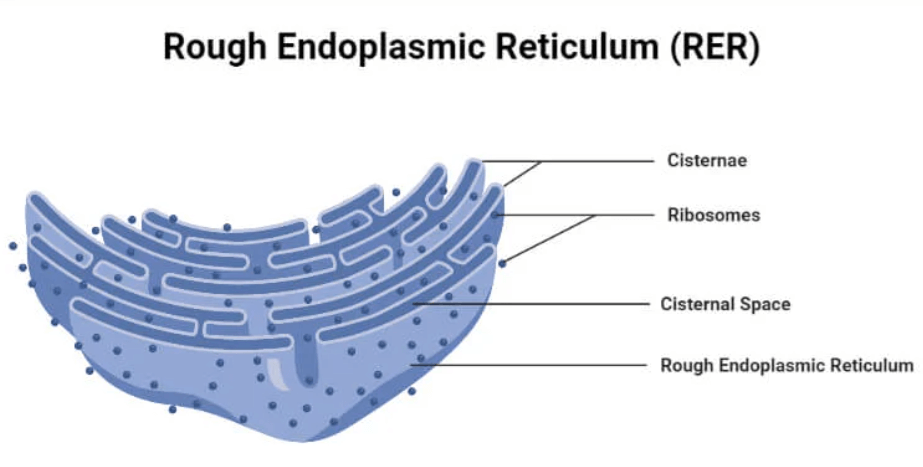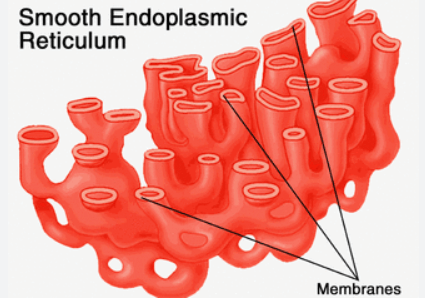The endoplasmic reticulum (ER) is a cell structure that acts like a factory, making and processing proteins and fats. The Endoplasmic Reticulum is of two types: rough endoplasmic reticulum and smooth endoplasmic reticulum. The rough endoplasmic reticulum consists of ribosomes on its surface for protein production, while the smooth endoplasmic reticulum is involved in lipid synthesis and lacks ribosomes. The endoplasmic reticulum helps maintain cell shape and structure, crucial for cell function. Here we have discussed a few differences between the rough endoplasmic reticulum and smooth endoplasmic reticulum below in the article.
Rough Endoplasmic Reticulum and Smooth Endoplasmic Reticulum
The endoplasmic reticulum (ER) is a vital organelle in Eukaryotic cells involved in various cellular processes. There are two types of endoplasmic reticulum: Rough endoplasmic reticulum and smooth endoplasmic reticulum. Both types of endoplasmic reticulum are interconnected and play crucial roles in maintaining cellular homeostasis and fulfilling different functions essential for the cell’s survival and functioning.
What is a Rough Endoplasmic Reticulum?
The rough endoplasmic reticulum (RER) is a membrane-bound organelle found in eukaryotic cells. It is called “rough” because it is studded with ribosomes on its cytoplasmic surface, giving it a bumpy appearance under a microscope. These ribosomes are responsible for protein synthesis. The primary function of the rough endoplasmic reticulum is the synthesis, folding, and modification of proteins.

Ribosomes on the RER produce proteins that are either secreted from the cell, incorporated into the cell membrane, or transported to an organelle called the lysosome. Proteins synthesized in the rough endoplasmic reticulum are often destined for secretion or for use within the cell, and they undergo various modifications and folding processes to achieve their functional, three-dimensional structures. In summary, the rough endoplasmic reticulum plays a crucial role in the synthesis and processing of proteins, which are essential for the proper functioning of cells.
What is a Smooth Endoplasmic Reticulum?
The smooth endoplasmic reticulum (SER) is a membrane-bound organelle found in eukaryotic cells. Unlike the rough endoplasmic reticulum (RER), the smooth endoplasmic reticulum lacks ribosomes on its surface, giving it a smooth appearance under a microscope. The smooth endoplasmic reticulum is involved in various metabolic processes within the cell, including lipid synthesis, metabolism of carbohydrates, detoxification of drugs and poisons, and regulation of calcium levels in the cell. It is also involved in the synthesis of steroid hormones and lipids essential for building cell membranes. In summary, the smooth endoplasmic reticulum plays a vital role in lipid synthesis, contributing to the overall functioning and homeostasis of the cell.

Difference Between Rough Endoplasmic reticulum and Smooth Endoplasmic Reticulum
The rough endoplasmic reticulum (RER) and the smooth endoplasmic (SER) are two types of endoplasmic reticulum found in eukaryotic cells, each with distinct structures and functions. The rough endoplasmic reticulum is mainly responsible for protein synthesis and processing, while the smooth endoplasmic reticulum is involved in lipid metabolism and detoxification processes within the cell.
| Difference Between Rough endoplasmic reticulum and Smooth Endoplasmic Reticulum | ||
| Features | Rough Endoplasmic Reticulum (RER) | Smooth Endoplasmic Reticulum (SER) |
| Ribosomes Presence | The rough endoplasmic reticulum consists of ribosomes that provide it a rough appearance. | The smooth endoplasmic reticulum lacks ribosomes that provide it with a smooth appearance. |
| Structure | The structure of the RER is flattened sac-like with ribosomes. | The structure of the SER is tubular and network-like without ribosomes. |
| Function | The rough endoplasmic reticulum is involved in the synthesis and processing of proteins. | The smooth endoplasmic reticulum is involved in lipid synthesis, metabolism, and detoxification processes. |
| Location | The RER is primarily found near the nucleus in eukaryotic cells. | The SER is distributed throughout the cell, often found near the cell periphery and around the nucleus. |
| Protein Synthesis | The RER is a site of synthesis of membrane proteins and proteins to be secreted. | The SER is not involved in protein synthesis. |
| Lipid Synthesis | The rough endoplasmic reticulum has a minimal role in lipid synthesis. | The smooth endoplasmic reticulum is the main site of lipid synthesis, including phospholipids and steroids. |
| Calcium Ion Regulation | The RER is not directly involved in calcium ion regulation. | The SER regulates calcium ion concentration in the cytoplasm, important for muscle contractions and other cellular processes. |
| Detoxification | The rough endoplasmic reticulum performs limited detoxification functions. | The smooth endoplasmic reticulum is involved in detoxification processes, especially in the liver cells. |
| Role in Cell | The RER found in the cell is actively involved in protein secretion (e.g., pancreatic cells). | The SER common in cells is involved in lipid metabolism and detoxification (e.g., liver cells). |
| Surface Area | The rough endoplasmic reticulum has a larger surface area due to the presence of ribosomes. | The smooth endoplasmic reticulum has a smaller surface area as compared to the rough endoplasmic reticulum. |
Functions of Rough and Smooth Endoplasmic Reticulum
The rough endoplasmic reticulum and smooth endoplasmic reticulum are two interconnected organelles within a eukaryotic cell, each with specific functions. Both rough and smooth endoplasmic reticulum are interconnected and have different functions, contributing to the overall functioning and health of the cell.
Functions of Rough Endoplasmic Reticulum (RER)
- Protein Synthesis: RER is studded with ribosomes on its surface, giving it a “rough” appearance. These ribosomes are involved in synthesizing proteins that are either secreted from the cell, incorporated into the cell membrane, or sent to lysosomes.
- Protein Folding and Modification: As newly synthesized proteins enter the RER, they undergo folding and may undergo post-translation modifications such as glycosylation (adding sugar molecules) which are essential for the protein’s proper function.
- Quality Control: RER helps in the quality control of proteins. Misfolded or improperly synthesized proteins are targeted for degradation or sent back to the cytoplasm for recycling.
- Membrane Synthesis: RER contributes to the synthesis of membranes, both for itself and for other cellular components.
Functions of Smooth Endoplasmic Reticulum
- Lipid Synthesis: SER is involved in lipid synthesis, including phospholipids and cholesterol. These lipids are vital components of the cell membrane.
- Detoxification: SER plays a crucial role in detoxifying drugs and poisons in liver cells. It achieves this by enzymatically modifying these harmful substances, making them easier to excrete from the body.
- Calcium Storage: SER stores and regulates cellular calcium levels. Calcium ions are involved in various cellular processes, including muscle contractions and signaling pathways.
- Carbohydrate Metabolism: SER is involved in glycogen metabolism in certain cell types, regulating blood sugar levels and providing energy when needed.



 50 Vegetables Name for Kids in English a...
50 Vegetables Name for Kids in English a...
 Food Chain: Definition, Types, Examples,...
Food Chain: Definition, Types, Examples,...
 Human Respiratory System: Definition, Di...
Human Respiratory System: Definition, Di...













